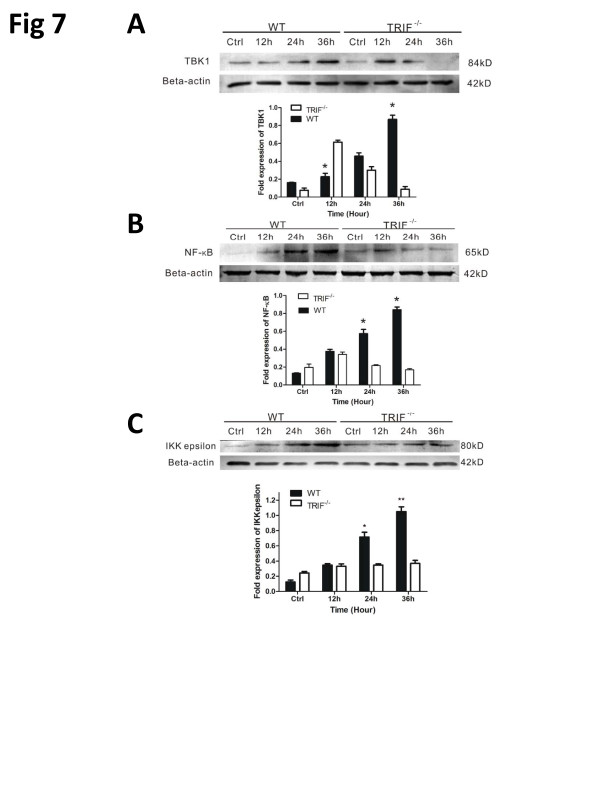Figure 7.
TIR-domain-containing adapter-inducing interferon-β (TRIF) deficiency attenuates microglial inflammatory factor release. Real-time reverse transcriptase (RT)-PCR and ELISA results of wild-type (WT) and trif-/- microglia pre-stimulated by injured RGCs in a transwell system to identify changes of inflammatory factors. (A-F) Measured by real-time RT PCR; (G-K) measured by ELISA. (A) Bar graphs showing interferon (IFN)-β mRNA expressed in the control, and at 12, 24, and 36 hours in WT and trif-/- microglia by real-time RT-PCR. Significant differences were seen at 36 hours in microglia pre-stimulated with injured RGCs. (B) Interleukin (IL)-1β mRNA expressed in the WT and trif-/- groups. At 12 hours, IL-1β mRNA expression was higher in the trif-/- than in the WT group; however, at 24 and 36 hours, it was higher in the WT than in the trif-/- group. (C) At 24 hours and 36 hours, tumor necrosis factor (TNF)-α was upregulated to a greater extent in the WT group. (D) IL-6 was significantly higher in the WT than in the trif-/- group at 24 and 36 hours. (E) IL-17 was upregulated at 36 hours in the WT. (F) Inducible nitric oxide synthase (iNOS) increased from 12 to 36 hours in the WT. Similar to the PCR results, (G) IFN-β release increased markedly at 24 and 36 hours. (H) IL-1β had a greater increase at 24 and 36 hours in the WT than in the trif-/- group; however, it was lower at 12 hours. (I) TNF-α concentration was significantly increased in the WT at 24 and 36 hours compared with the trif-/- group. (J) IL-6 concentration was significantly increased in the WT at 24 and 36 hours compared with the trif-/- group. (K) IL-17 concentration was significantly increased in the WT at 12, 24, and 36 hours compared with trif-/- group. Experiments were performed in triplicate. n = 3, *P <0.05 vs. increase relative to the trif-/-group (WT group at the same time point). β-actin mRNA was used as an internal control.

